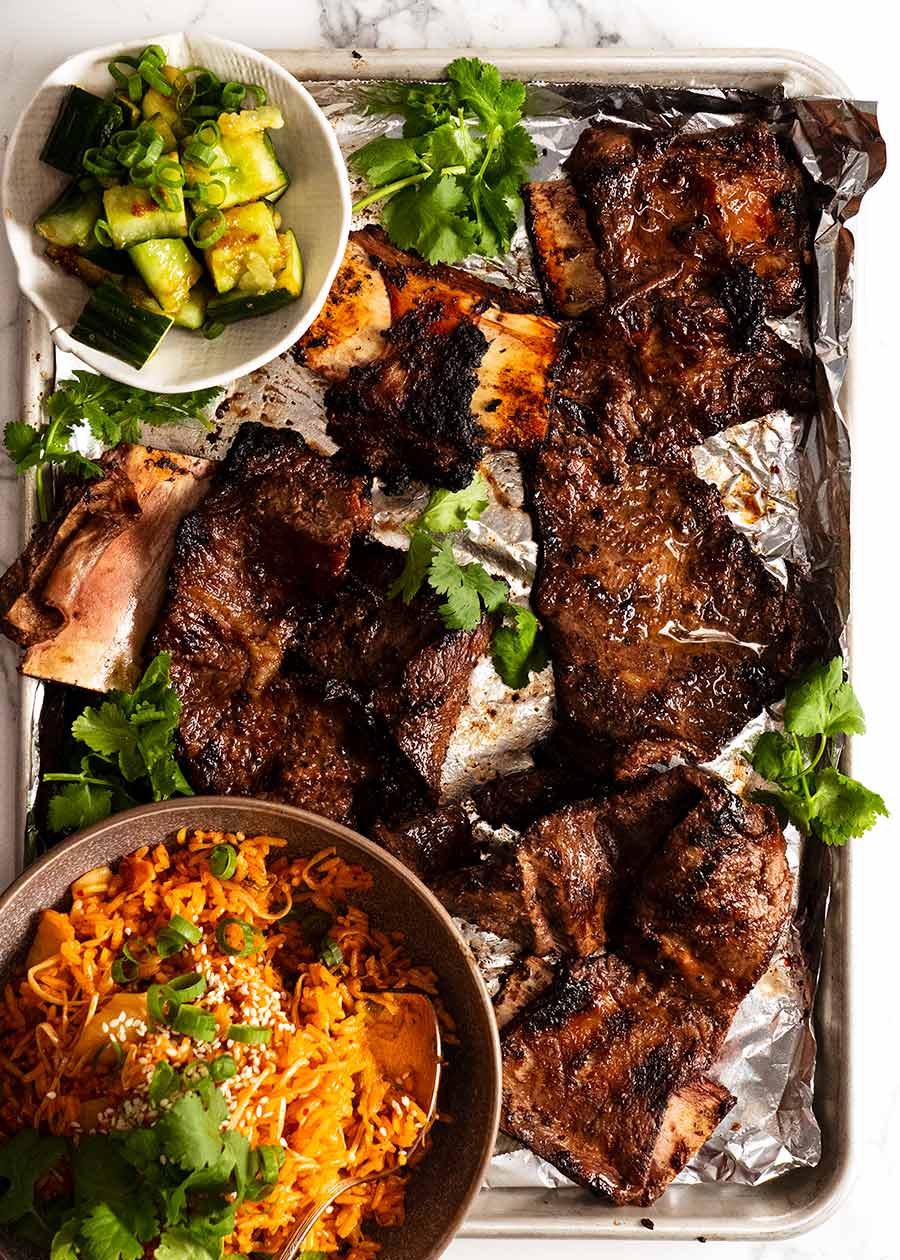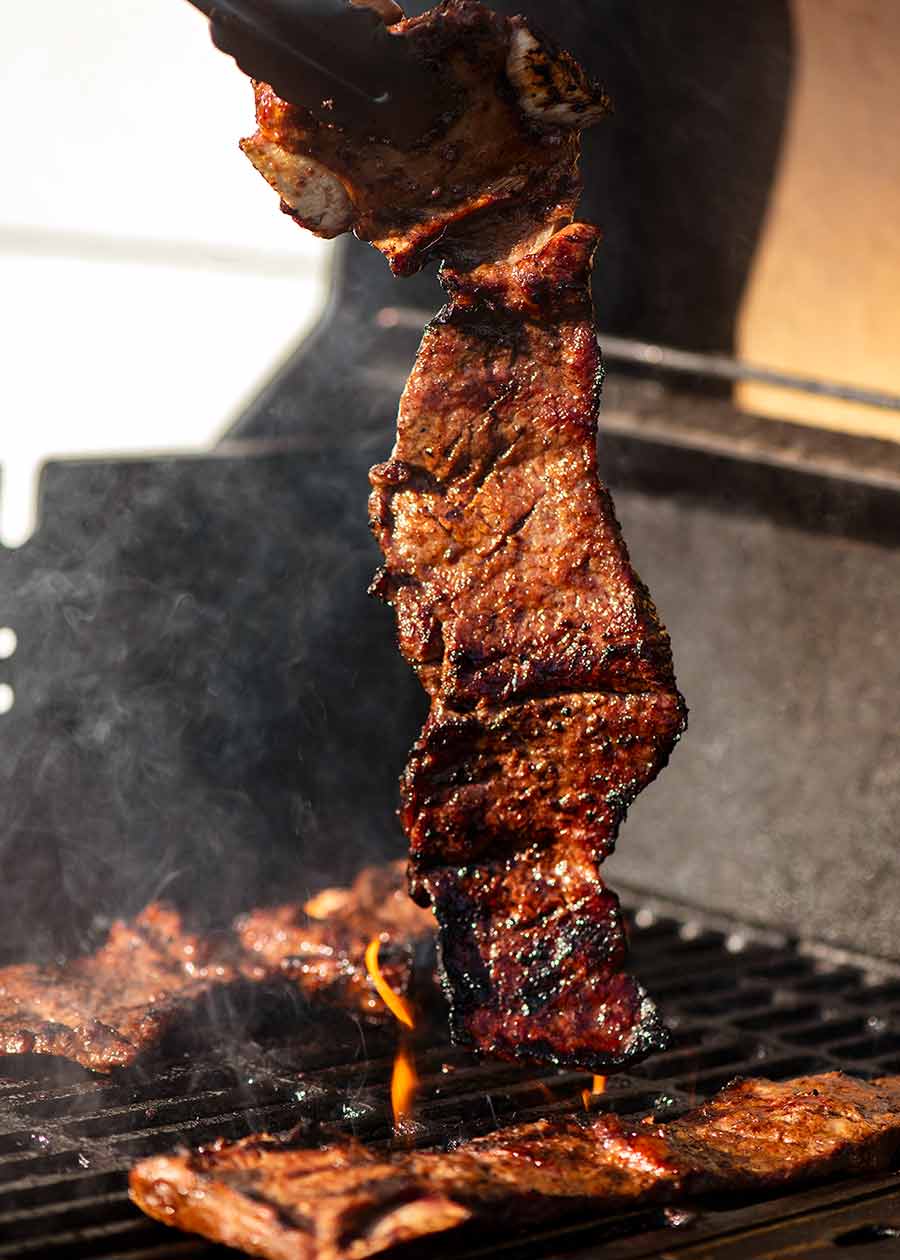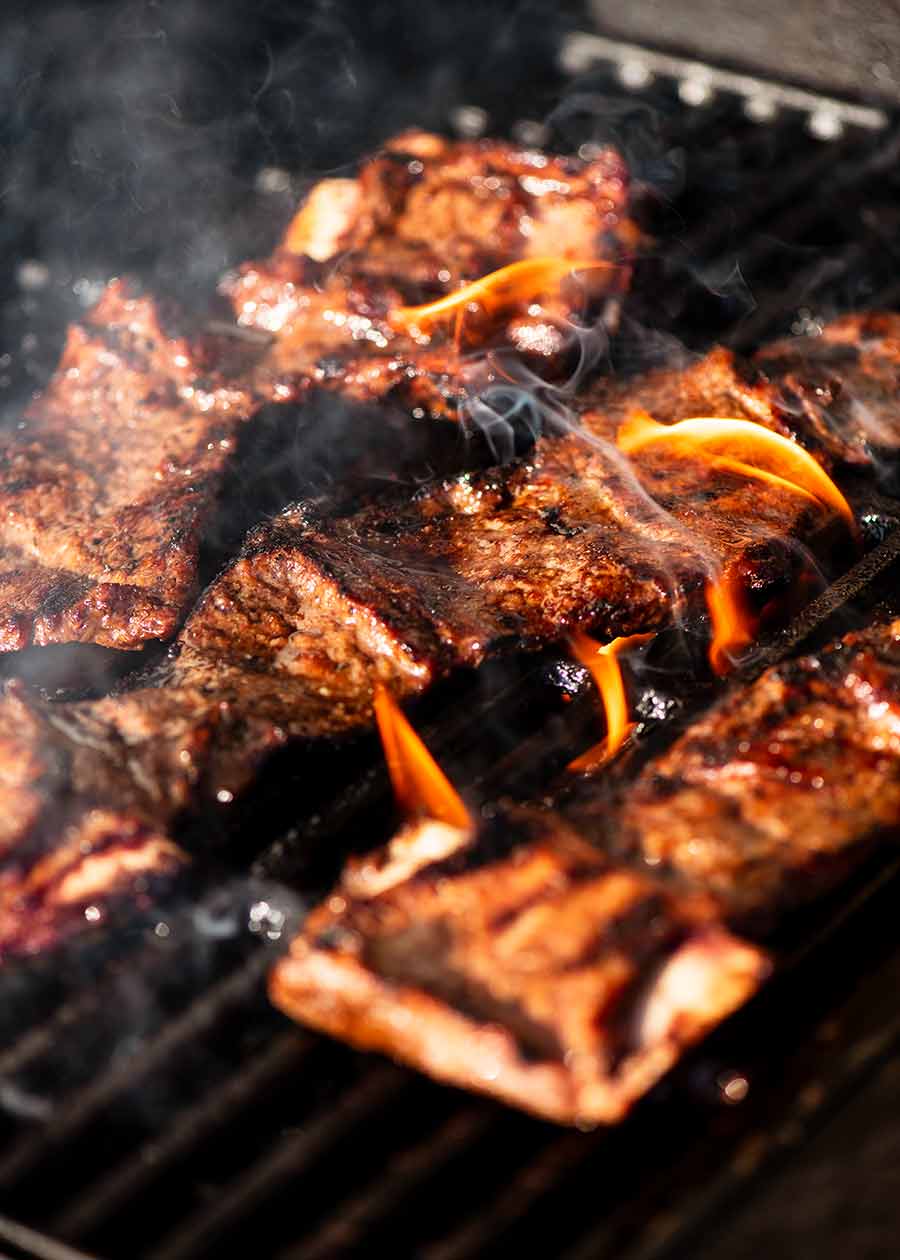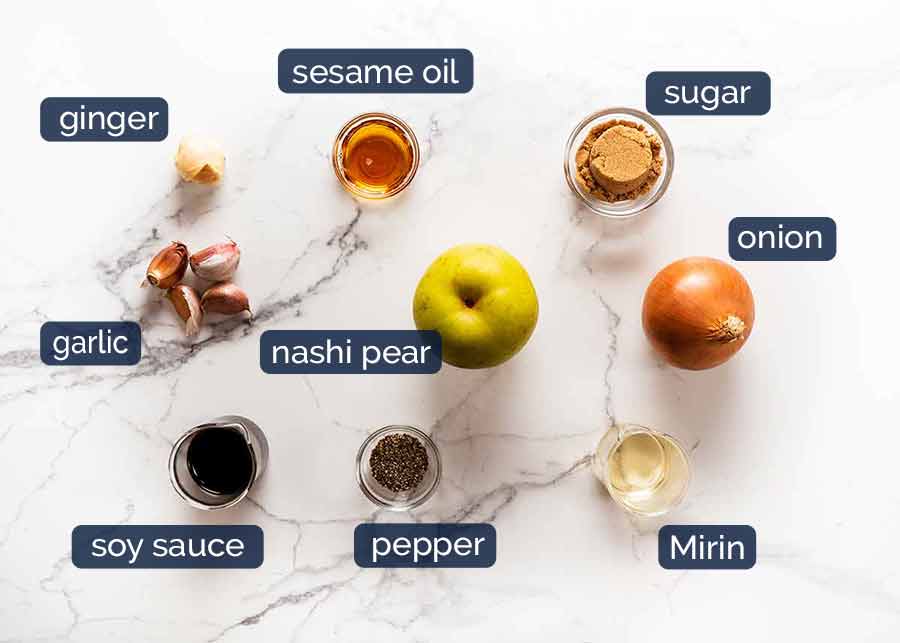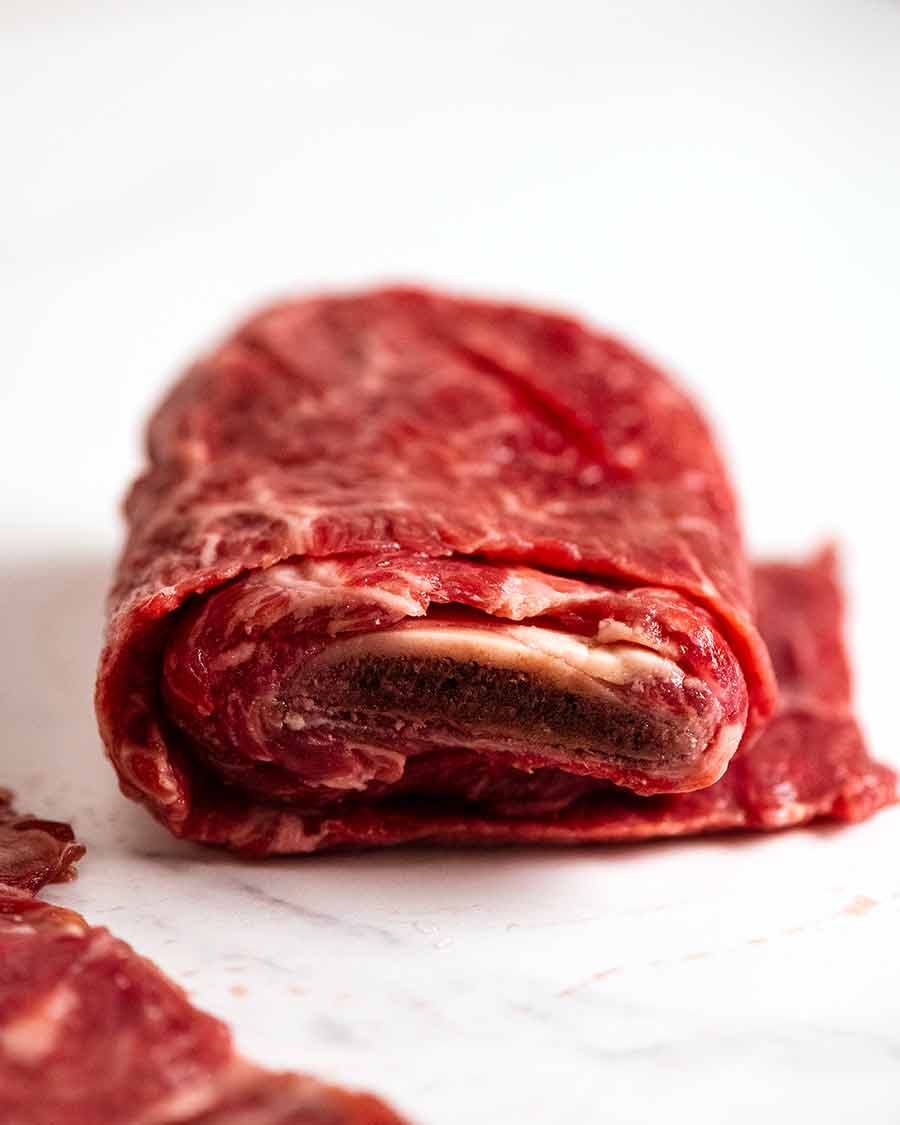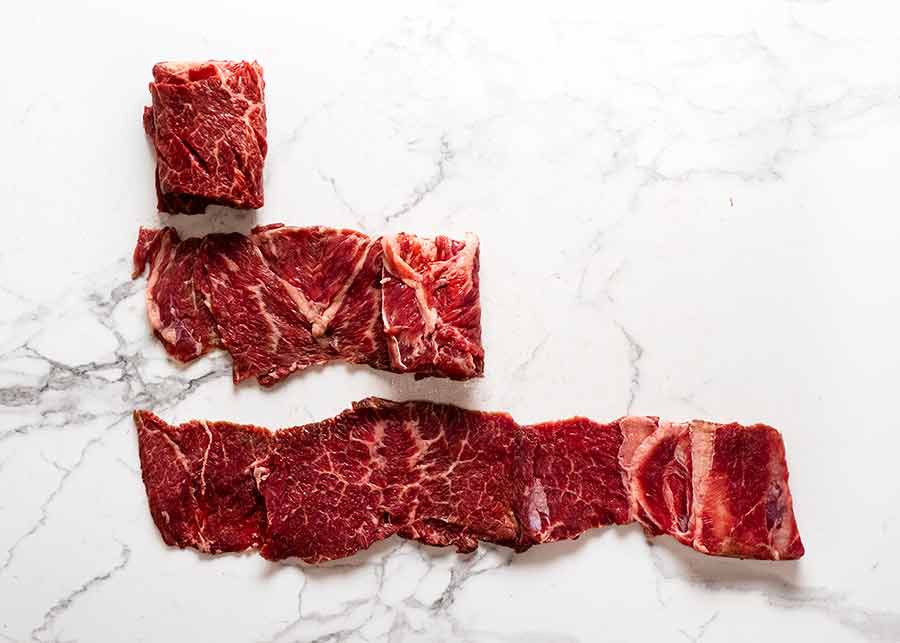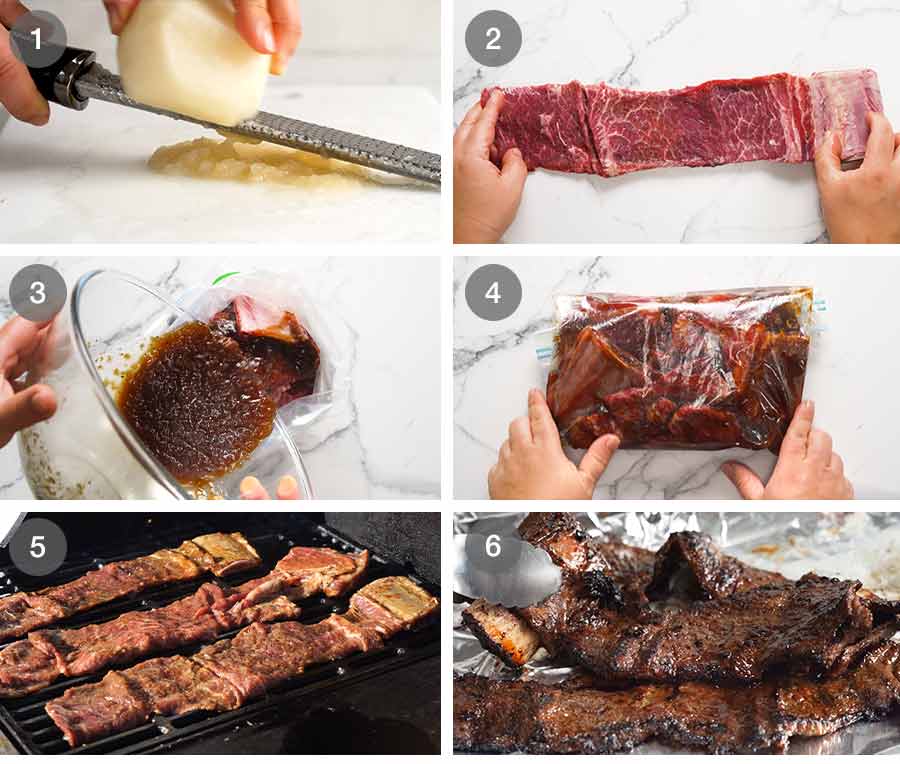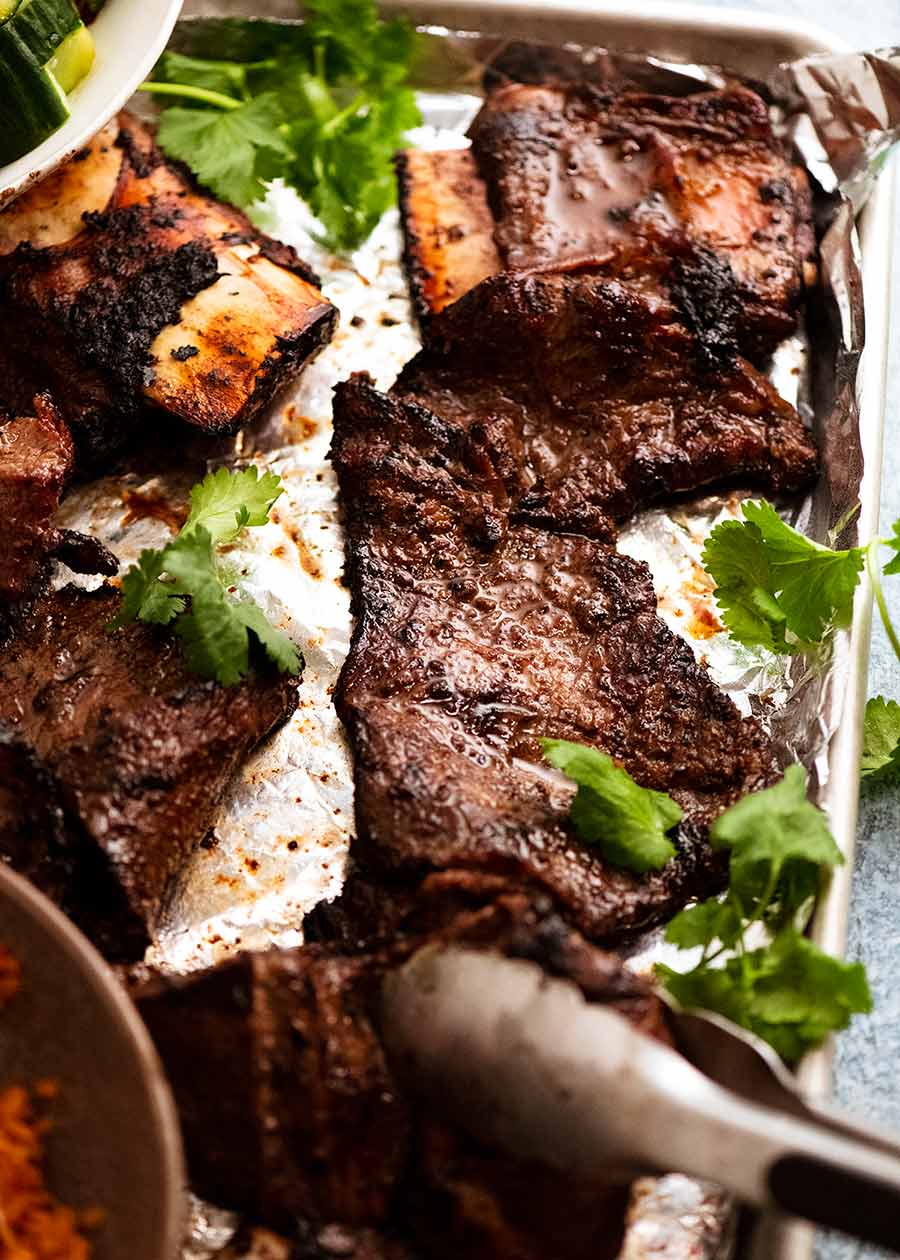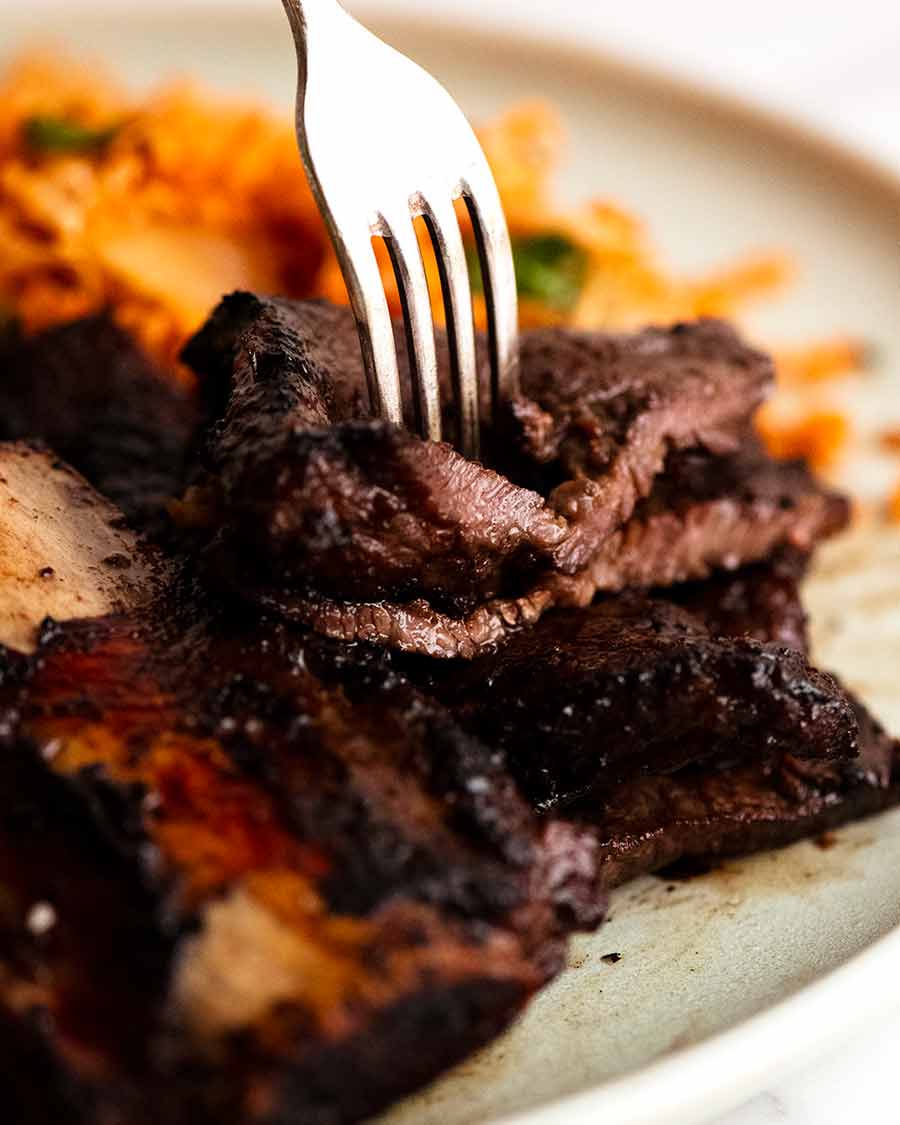Once grilled, the succulent meat is at once sweet, savoury, garlicky, and smoky in flavour. The Koreans know a thing or two about good BBQ!
Korean BBQ Marinated Beef Short Ribs
Korean barbecue is one of the first things that come to mind when people think of Korean food. And it’s world famous for good reason! I love that it’s as much of a social event as it is an eating one, enjoyed by groups huddled around a table embedded with a grill sizzling with marinated meats, seafood and vegetables. Interactive food, I call it. And I’m 100% on board! Of all the marinated barbecued meats, I am pretty sure that Korean Short Ribs is one of the most well known. Koreans prize this cut for its rich beefy flavour, while the addition of the marinade tenderises, flavours and encourages delicious caramelisation on the meat as it barbecues. Korean Short Ribs are also notable for the unique way they are cut: The meat is “unrolled” to form a long, thin flap still attached to the bone. This not only ensures maximum marinade penetration but also that the meat cooks quickly, while making it easier to eat. Like I said, Koreans have their barbecue game all figured out!
Korean Barbecue Marinade for Beef Short Ribs
The DIY cooking experience aside, one of the things that makes Korean BBQ so great are the Korean barbecue marinades. There’s a few things makes Korean barbecue marinades so distinctive:
Ingredients in Korean BBQ Marinade for Beef Short Ribs
Here’s what you need for the Korean Barbecue Marinade:
Nashi pear or normal pear or apple – The unique ingredient in Korean Barbecue Marinades, nashi pear and other fruits have natural tenderising qualities that can soften the fibres of even the toughest cuts of meat. Beef short ribs are typically slow-cooked until fall apart tender (such as in this recipe and this recipe), yet here the meat is suitable for even barbecuing thanks to the marinade. “Nashi” is the Japanese word for “pear”. (So really, “nashi pear” means “pear pear”! 😂) It’s also known by various other names including Korean pear, Asian pear, Chinese pear, apple pear and sand pear, to name a few. It’s shaped like a round apple rather than the distinctive pear shape, but with a flesh texture and taste similar to a crisp pear. Except – dare I say it – juicier and tastier than most pears!Nashi pear is typically available throughout autumn and winter, though often I see them well into spring. Best substitutes: Normal pears or red apples. They have a very similar flavour and tenderising effect in end result;Garlic – Korean food is known for being liberal with the garlic, and Korean marinades are no exception!Ginger – The garlic plays a dominant role here, but ginger adds a lovely fragrant back note. I consider ginger to be complimentary and highly recommended but not essential;Onion – An essential savoury base ingredient, especially with the unique way in which it is finely grated;Mirin – Japanese sweet cooking wine which adds depth and complexity into the marinade and, well, anything it comes into contact with!;Soy sauce – For flavour and salt;Sesame oil – Like garlic, Koreans are very fond of sesame oil, and we do not complain!Sugar – Adds more sweetness as well as terrific caramelisation on the beef; andBlack pepper – For a touch of warmth.
Beef Short Rib cut used for Korean BBQ
Beef ribs are a thick meaty cuts on the bone that are typically slow-cooked as hunks in Western cuisine, to break down the tough fibres until they become meltingly tender, such as these Beef Ribs in Red Wine Sauce. “Nashi” is the Japanese word for “pear”. (So really, “nashi pear” means “pear pear”! 😂) It’s also known by various other names including Korean pear, Asian pear, Chinese pear, apple pear and sand pear, to name a few. It’s shaped like a round apple rather than the distinctive pear shape, but with a flesh texture and taste similar to a crisp pear. Except – dare I say it – juicier and tastier than most pears! Nashi pear is typically available throughout autumn and winter, though often I see them well into spring. Best substitutes: Normal pears or red apples. They have a very similar flavour and tenderising effect in end result; In contrast, for Korean BBQ, beef short ribs are cut for cooking in various ways. They may be boneless, served as small, ready-to-grill, bite-sized pieces. Otherwise they may be cut with bone still attached. This can be one of two ways. The first is known as “flanken cut” (also called LA galbi in the USA, and asado in other parts of the world including Australia), where the meat slices are cut across the ribs so you have several small pieces of rib per slice. The other is “English cut” ribs, where there is a single, longer rib bone section per slice. In Korean butchery these are cut smaller than you’ll typically find in the shops here in Australia. Also, and most characteristically, the meat is butterflied out into one long, thin piece of beef that unrolls, still attached to the bone. The latter, butterflied beef short ribs, is what I’ve used today. This and the boneless cuts are rarely found at Western butchers, you need to get them from Korean or Asian butchers. But don’t worry, see below for an easily accessible substitution!! The photos below show what butterflied beef short ribs looks like. The top photo is how it is sold at the Korean butchers, with the meat rolled up on the bone. The second photo shows what it looks like unrolled.
Best options / substitutions for Korean cut beef short ribs
The best options and substitutions for Korean cut beef short ribs are: While oyster blade might not be a well-known cut of beef here in Australia, it is in fact even sold at large supermarkets (Coles, Woolworths, Harris Farms) and is one of the better value cuts of beef.
It can be slow or fast cooked;It has a similar beefy flavour; andWhen sliced thinly and marinated in a Korean BBQ marinade, it stays nice and juicy even when grilled long enough to caramelise (which necessarily pushes the thinly sliced beef far into well-done territory).
To use oyster blade, simply finely slice it and use per the recipe in place of the beef short ribs. If you get the oyster blade in steak form (which is how it’s typically sold at supermarkets), then slice it thinly on an angle to get pieces with a larger surface area (partially freezing it helps). The last option (expert level!) is: butterfly your own Korean beef ribs! Sometimes you can find suitable sized short ribs on the bone, but not butterflied. If you are confident, you can butterfly your own. It is not difficult if you are competent with a knife and take your time. You need pieces with ribs about the size you see in my photos, ie. ~8cm / 3″ long. The cutting part however is out of scope of this post, so follow this handy tutorial from Modern Pepper (a Korean cooking website) to see how to do it.
How to make Korean BBQ Beef Short Ribs
One of the distinguishing techniques used in Korean marinades is that onion and fruit (nashi pear, in this case) are finely grated for maximum effect and flavour in the marinade.
What to serve with Korean Marinated BBQ Beef Short Ribs
Korean food is equally well known for the selection of delicious, simple, and mostly vegetable side dishes known as banchan that are offered up alongside the main meal. The count can run from just a modest couple in the home to up to a dozen in some restaurants, where every available surface on the table is crammed with a dizzying array of sides served in individual dishes (spare a thought for the poor soul on dish washing duty!) It takes around 2 – 3 minutes on a hot BBQ to caramelise each side, by which time the inside of the thin slices of beef are very, very well done – in fact, technically overcooked for meat this thin. But do not worry, this is intentional! Why? Because the marinade keeps it tender. In fact, I’ve cooked it for well over 10 minutes and it was still unbelievably tender. Seriously. This Korean marinade is foolproof magic! Kimchi (either store-bought or home-made) is a must, and potato salad nearly always makes an appearance. Some kind of simple lettuce salad – say, lettuce, some canned corn kernels, thinly sliced onion – is also typical (my Asian sesame dressing would be perfect here!) Plainly stir-fried vegetables also make great accompaniments to richly flavoured Korean mains. So any of the individual vegetable preparations in my bibimbap are also essentially mini-banchan recipes! Meanwhile I can also offer up some other very typical Korean banchan recipes I’ve used from other websites:
Bean sprout or soybean sprout salad – from the loveable Maangchi!Pickled radishes (easy) – from My Korean Kitchen (one of my go-to sources of authentic Korean recipes); andKorean Sesame Spinach Salad (easy) – also from My Korean KitchenSweet Soy Potatoes – from DriveMeHungry
Pictured in post are Kimchi Fried Rice and Ginger Smashed Cucumbers (both my recipes) which are a sensational pairing with this juicy Korean beef. I love the fiery red colour of the fried rice, which looks much more fierce than it actually is in taste! And here are a few more options for you: Happy Korean cooking! – Nagi x
Watch how to make it
The Spicy Side of Life: Korean recipes
Life of Dozer
When I cheated on Dozer in Tasmania!!! 💔 This is Oscar the trail dog, owned by a friend, who is actually able to keep up on mountain bike riding trails. Dozer, on the other hand, is no long distance runner, so he stayed at home with the golden retriever boarder. This is in Derby, Tasmania – just got back last night! And here is Dozer and I, reunited. He knows I’ll always be faithful to him…..!!
